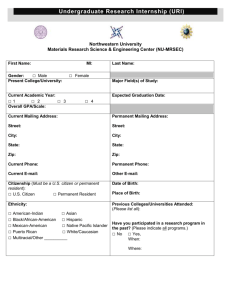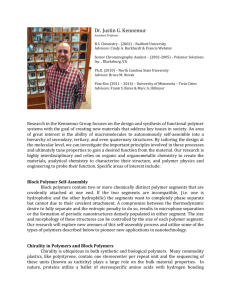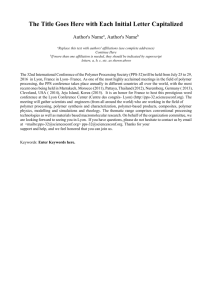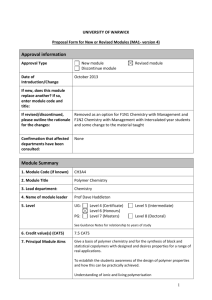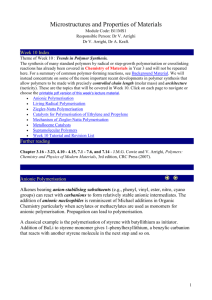Microstructures and Properties of Materials - Heriot
advertisement
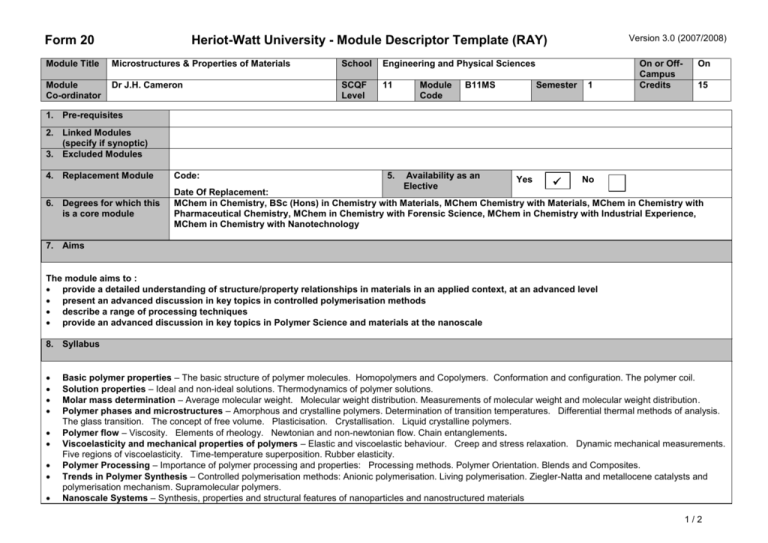
Form 20 Version 3.0 (2007/2008) Heriot-Watt University - Module Descriptor Template (RAY) Module Title Microstructures & Properties of Materials School Engineering and Physical Sciences Module Co-ordinator Dr J.H. Cameron SCQF Level 11 Module Code B11MS Semester 1 On or OffCampus Credits On 15 1. Pre-requisites 2. Linked Modules (specify if synoptic) 3. Excluded Modules 4. Replacement Module 6. Degrees for which this is a core module Code: 5. Availability as an Elective Yes No Date Of Replacement: MChem in Chemistry, BSc (Hons) in Chemistry with Materials, MChem Chemistry with Materials, MChem in Chemistry with Pharmaceutical Chemistry, MChem in Chemistry with Forensic Science, MChem in Chemistry with Industrial Experience, MChem in Chemistry with Nanotechnology 7. Aims The module aims to : provide a detailed understanding of structure/property relationships in materials in an applied context, at an advanced level present an advanced discussion in key topics in controlled polymerisation methods describe a range of processing techniques provide an advanced discussion in key topics in Polymer Science and materials at the nanoscale 8. Syllabus Basic polymer properties – The basic structure of polymer molecules. Homopolymers and Copolymers. Conformation and configuration. The polymer coil. Solution properties – Ideal and non-ideal solutions. Thermodynamics of polymer solutions. Molar mass determination – Average molecular weight. Molecular weight distribution. Measurements of molecular weight and molecular weight distribution. Polymer phases and microstructures – Amorphous and crystalline polymers. Determination of transition temperatures. Differential thermal methods of analysis. The glass transition. The concept of free volume. Plasticisation. Crystallisation. Liquid crystalline polymers. Polymer flow – Viscosity. Elements of rheology. Newtonian and non-newtonian flow. Chain entanglements. Viscoelasticity and mechanical properties of polymers – Elastic and viscoelastic behaviour. Creep and stress relaxation. Dynamic mechanical measurements. Five regions of viscoelasticity. Time-temperature superposition. Rubber elasticity. Polymer Processing – Importance of polymer processing and properties: Processing methods. Polymer Orientation. Blends and Composites. Trends in Polymer Synthesis – Controlled polymerisation methods: Anionic polymerisation. Living polymerisation. Ziegler-Natta and metallocene catalysts and polymerisation mechanism. Supramolecular polymers. Nanoscale Systems – Synthesis, properties and structural features of nanoparticles and nanostructured materials 1/2 Form 20 Version 3.0 (2007/2008) Heriot-Watt University - Module Descriptor Template (RAY) Module Title Microstructures & Properties of Materials School Engineering and Physical Sciences Module Co-ordinator Dr J.H. Cameron SCQF Level 11 Module Code B11MS Semester 1 On or OffCampus Credits On 15 9. Learning Outcomes (HWU Core Skills: Employability and Professional Career Readiness) Subject Mastery Understanding, Knowledge and Cognitive Skills Scholarship, Enquiry and Research (Research-Informed Learning) On completion of this module, the learner will be able to: Demonstrate detailed knowledge and understanding in all main areas of polymer science Display a critical understanding of the main concepts, theories and principles relating to polymeric materials and nanoscale materials; their properties, structure, processing and synthesis Demonstrate detailed and critical knowledge of specialised polymer concepts and theories, at the forefront of the subject Display a critical awareness of current issues in polymer science and nanochemistry Use fundamental principles to solve both qualitative and numerical problems of an advanced nature Analyse, evaluate and interpret experimental evidence at the forefront of polymer chemistry and nanotechnology Demonstrate knowledge of the unique properties exhibited by materials in which one or more dimensions lie in the nanoscale range Personal Abilities Industrial, Commercial & Professional Practice Autonomy, Accountability & Working with Others Communication, Numeracy & ICT Personal abilities are embedded in the module. The module provides the opportunity to : Critically review, consolidate and extend knowledge of structure-property relationships Exercise substantial independence and initiative in carrying out learning activities Take responsibility for own work Manage time effectively, work to deadlines and prioritise workloads Communicate effectively to a range of audiences with different levels of knowledge Interpret and critically evaluate numerical and graphical data, at the forefront of the field Use a wide range of software to support and enhance work Use ICT skills with on-line materials as the main means of support of the learning process Apply strategies for appropriate selection of relevant information from a wide source and large body of knowledge 10. Assessment Methods 11. Re-assessment Methods Method Duration of Exam Weighting (%) Synoptic modules? Method (if applicable) Modular Examination Continuous Assessment 2h Duration of Exam (if applicable) 70% 30% 12. Date and Version Date of Proposal 27 September, 2007 Date of Approval by School Committee Date of Implementation 15 September, 2008 Version Number 1.0 2/2


